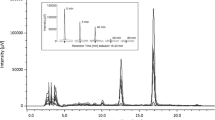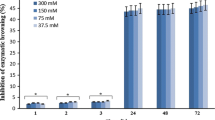Abstract
Strawberry fruit contains many constituents, some of which have the potential to inhibit histidine decarboxylase (HDC) activity. HDC converts l-histidine to histamine, which is associated with allergic and other biological reactions in the human body. The HDC inhibition levels were different and the component ratios varied by genotype in strawberry. Among the 11 cultivars collected locally in Japan, ‘Tokun’ had an approximately ten times higher inhibition ratio than the lowest cultivar. The reproducibility was confirmed using five cultivars under the same conditions in a glass greenhouse, suggesting that genotypic variation is a major factor of HDC inhibition. The potential inhibitors of HDC might be polyphenols because they showed moderate correlations with HDC inhibition rates. Among the polyphenols, the anthocyanin content possessed a moderate negative correlation. Ascorbic acid, which contributes to the overestimation of total polyphenol, did not independently inhibit HDC activity. These findings will support the identification of potential HDC inhibitors in strawberry and indicated that genotypic differences would make useful probes for inhibitor identification.




Similar content being viewed by others
Abbreviations
- AsA:
-
Ascorbic acid
- HDC:
-
Histidine decarboxylase
References
Aaby K, Mazur S, Nes A, Skrede G (2012) Phenolic compounds in strawberry (Fragaria × ananassa Duch.) fruits: composition in 27 cultivars and changes during ripening. Food Chem 132:86–97. doi:10.1016/j.foodchem.2011.10.037
Andersson K, Cabero JL, Mattsson H, Hakanson R (1996) Gastric acid secretion after depletion of enterochromaffin-like cell histamine. A study with alphafluoromethylhistidine in rats. Scand J Gastroenterol 31:24–30
Deiteren A, De Man JG, Pelckmans PA, De Winter BY (2015) Histamine H4 receptors in the gastrointestinal tract. Br J Pharmacol 172:1165–1178. doi:10.1111/bph.12989
Gasperotti M, Masuero D, Guella G, Palmieri L, Martinatti P, Pojer E, Mattivi F, Vrhovsek U (2013) Evolution of ellagitannin content and profile during fruit ripening in Fragaria spp. J Agric Food Chem 61:8597–8607. doi:10.1021/jf402706h
Georgé S, Brat P, Alter P, Amiot MJ (2005) Rapid determination of polyphenols and vitamin c in plant-derived products. J Agric Food Chem 53:1370–1373. doi:10.1021/jf048396b
Giampieri F, Alvarez-Suarez JM, Battino M (2014) Strawberry and human health: effects beyond antioxidant activity. J Agric Food Chem 62:3867–3876. doi:10.1021/jf405455n
Giusti MM, Rodríguez-Saona LE, Wrolstad RE (1999) Molar absorptivity and color characteristics of acylated and non-acylated pelargonidin-based anthocyanins. J Agric Food Chem 47:4631–4637. doi:10.1021/jf981271k
Itoh T, Ninomiya M, Yasuda M, Koshikawa K, Deyashiki Y, Nozawa Y, Akao Y, Koketsu M (2009) Inhibitory effects of flavonoids isolated from Fragaria ananassa Duch on IgE-mediated degranulation in rat basophilic leukemia RBL-2H3. Bioorg Med Chem 17:5374–5379. doi:10.1016/j.bmc.2009.06.050
Iwamoto A, Mitsuda K, Inoue A, Kato T, Inoue Y, Kawahara H (2012) Purification and identification of an IgE suppressor from strawberry in an in vitro immunization system. Cytotechnology 64:309–314. doi:10.1007/s10616-012-9432-7
Koyama R, Itoh H, Kimura S, Morioka A, Uno Y (2012) Augmentation of antioxidant constituents by drought stress to roots in leafy vegetables. HortTechnology 22:121–125
Manach C, Williamson G, Morand C, Scalbert A, Rémésy C (2005) Bioavailability and bioefficacy of polyphenols in humans. I. Review of 97 bioavailability studies. Am J Clin Nutr 81:230S–242S
Mitsuda K, Inoue A, Nishino N, Inoue Y, Kawahara H (2010) Detection of anti-allergic effects in strawberry extracts. In: Kamihira M et al (eds) Proceedings of the 21st annual and international meeting of the Japanese association for animal cell technology, Fukuoka, November 2008. Animal cell technology: basic and applied aspects, vol 16. Springer, Dordrecht, pp 353–358
Muñoz C, Sánchez-Sevilla JF, Botella MA, Hoffmann T, Schwab W, Valpuesta V (2011) Polyphenol composition in the ripe fruits of Fragaria species and transcriptional analyses of key genes in the pathway. J Agric Food Chem 59:12598–12604. doi:10.1021/jf203965j
Ninomiya M, Itoh T, Ishikawa S, Saiki M, Narumiya K, Yasuda M, Koshikawa K, Nozawa Y, Koketsu M (2010) Phenolic constituents isolated from Fragaria ananassa Duch. inhibit antigen-stimulated degranulation through direct inhibition of spleen tyrosine kinase activation. Bioorg Med Chem 18:5932–5937. doi:10.1016/j.bmc.2010.06.083
Nitta Y, Kikuzaki H, Ueno H (2007) Food components inhibiting recombinant human histidine decarboxylase activity. J Agric Food Chem 55:299–304. doi:10.1021/jf062392k
Nitta Y, Ito K, Ueno H (2008) Inhibitory activity of medicinal plants toward human histidine decarboxylase. J Home Econ Jpn 59:1011–1016 (in Japanese with English abstract)
Nitta Y, Kikuzaki H, Ueno H (2009) Inhibitory activity of Pimenta dioica extracts and constituents on recombinant human histidine decarboxylase. Food Chem 113:445–449. doi:10.1016/j.foodchem.2008.07.078
Nitta Y, Kikuzaki H, Azuma T, Ye Y, Sakaue M, Higuchi Y, Komori H, Ueno H (2013) Inhibitory activity of Filipendula ulmaria constituents on recombinant human histidine decarboxylase. Food Chem 138:1551–1556. doi:10.1016/j.foodchem.2012.10.074
Noguchi Y, Yamada T (2014) Flower bud initiation of a decaploid strawberry ‘Tokun’ by night chilling and short day treatment. Acta Hortic 1049:907–910
Ohshita J, Okigami H, Nitta Y, Ueno H (2007) Evaluation of inhibitory effects of spice–derived natural extracts on histidine decarboxylase. J Home Econ Jpn 58:17–22 (in Japanese with English abstract)
Parsons ME, Ganellin CR (2006) Histamine and its receptors. Br J Pharmacol 147:S127–S135. doi:10.1038/sj.bjp.0706440
San Mauro Martin I, Brachero S, Garicano Vilar E (2016) Histamine intolerance and dietary management: a complete review. Allergol Immunopathol (Madr) 44:475–483. doi:10.1016/j.aller.2016.04.015
Tanaka S, Hamada K, Yamada N, Sugita Y, Tonai S, Hunyady B, Palkovits M, Falus A, Watanabe T, Okabe S, Ohtsu H, Ichikawa A, Nagy A (2002) Gastric acid secretion in l-histidine decarboxylase-deficient mice. Gastroenterology 122:145–155. doi:10.1053/gast.2002.30312
Terauchi M, Matsuo T, Toyota A, Kanamori H, Shibata K, Fujiwara T, Kohmura H, Itou E, Nakatsu S, Muto N (2007) Antioxidant activity and anti-allergic activity of Fragaria × ananassa leaf. Jpn J Phcog 61:18–23 (in Japanese with English abstract)
Acknowledgements
We are extremely grateful to Drs. Takeshi Nabe (Setsunan University, Japan), Hiroki Tsuruta (Kobe University, Japan), Miho Iduhara (Biostir, Inc., Japan) and Kazuyoshi Sone (NARO/KARC, Japan) for their valuable suggestions and fruitful discussions. We are also thankful to Manabu Narukami and Daisuke Futsuki (Kobe University, Japan) for their technical assistance.
Author information
Authors and Affiliations
Corresponding author
Ethics declarations
Funding
This study was funded by the Hyogo Alliance of Universities and Colleges for Innovation, Japan, and by the Japan Society for the Promotion of Science KAKENHI (Grant Number 24658030).
Additional information
Communicated by L. A. Kleczkowski.
Rights and permissions
About this article
Cite this article
Uno, Y., Nitta, Y., Ishibashi, M. et al. Inhibition of recombinant human histidine decarboxylase activity in different strawberry cultivars. Acta Physiol Plant 39, 134 (2017). https://doi.org/10.1007/s11738-017-2430-9
Received:
Revised:
Accepted:
Published:
DOI: https://doi.org/10.1007/s11738-017-2430-9




